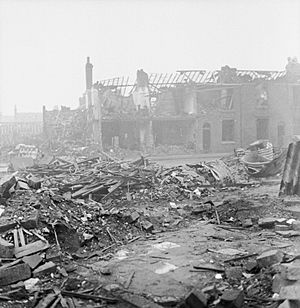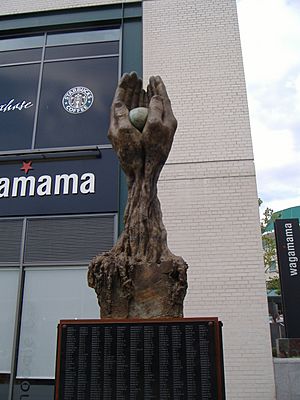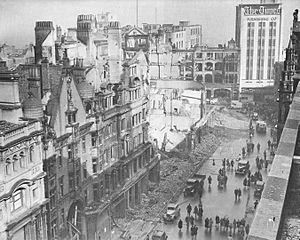Birmingham Blitz facts for kids
Quick facts for kids Birmingham Blitz |
|||||||
|---|---|---|---|---|---|---|---|
| Part of the Strategic bombing campaign of World War II | |||||||
 High Street, looking towards the Bull Ring area after heavy bombing, on 10 April 1941. |
|||||||
|
|||||||
| Combatants | |||||||
| Commanders and leaders | |||||||
| Units involved | |||||||
| Casualties and losses | |||||||
| Unknown |
|
||||||
The Birmingham Blitz was a period of heavy bombing of the city of Birmingham in central England. It happened during World War II, from August 1940 to April 1943. German planes from the Luftwaffe carried out these attacks.
Birmingham was a very important city for industry and making things. It was the largest British city outside London. Because of this, it was a major target for German bombers. About 1,852 tons of bombs were dropped on Birmingham. This made it the third most bombed city in the United Kingdom during the war. Only London and Liverpool were hit harder.
Nearby towns in the Black Country also suffered from bombing. Places like Dudley, Tipton, Smethwick, and West Bromwich had many casualties. During the war, news reports did not name Birmingham directly. They called it a "Midland Town" to keep the Germans from knowing how successful their raids were.
Contents
What Was the Damage Like?
Birmingham experienced 365 air raid alerts during the Blitz. There were 77 actual air raids. Eight of these were "major" raids, meaning over 100 tons of bombs were dropped. Official records show that 5,129 high explosive bombs hit the city. Also, 48 parachute mines and thousands of incendiary bombs fell.
About one-fifth of the high explosive bombs did not explode. One-third of the parachute mines got stuck in trees or other obstacles. In total, 2,241 people were killed. Another 3,010 were seriously injured, and 3,682 had minor injuries. The bombings destroyed 12,391 houses, 302 factories, and 239 other buildings. Many more were damaged.
Key Events During the Blitz

The first air raid on Birmingham was on August 9, 1940. A single plane dropped bombs on Erdington, killing one person. On August 13, the aircraft factory in Castle Bromwich was attacked. This factory made Spitfire planes. Eleven bombs hit the factory, causing a lot of damage. Seven people died, and 41 were injured.
The city centre was first bombed on August 25/26. Twenty-five people were killed. The old Market Hall in the Bull Ring was destroyed by fire. The BSA factory in Small Heath was also hit. This factory made rifle barrels and machine guns for aircraft.
Smaller raids continued through August, September, October, and early November. The city centre was hit hard between October 25 and 30. Buildings like Birmingham University, the Art Gallery, and the Town Hall were damaged. The roof of the Council House caught fire. St Philip's Cathedral also suffered fire damage.
In November 1940, Birmingham faced a series of very heavy air raids. From November 19 to 28, about 800 people were killed. Another 2,345 were injured, and 20,000 people lost their homes.
The first major raid happened on November 19. This was just five days after a huge attack on nearby Coventry. Around 440 German bombers attacked Birmingham. They killed 450 people and seriously injured 540. About 400 tons of high explosives were dropped. This included 18 parachute mines. This raid was the worst attack on Birmingham during the war. Many factories were badly damaged, including Lucas Industries and GEC works. The BSA factory was also hit hard. This stopped rifle production for three months. Prime Minister Winston Churchill was very worried about this.
The next night, 200 bombers returned. They dropped 118 tons of explosives and 9,500 incendiary bombs. This caused widespread damage. The main bus depot in Hockley was hit. About 100 buses were destroyed or damaged.
A third major raid followed on November 21/22. This raid lasted eleven hours. Many incendiary bombs were dropped, starting over 600 fires. The city's water supply system was badly damaged. Three-fifths of the city lost its main water supply. Firefighters had to get water from the city's canals. Fire brigades from other parts of the country came to help. The fires were eventually put out.
On December 4, about 60 bombers attacked Birmingham. The Witton tram depot was badly damaged. One week later, on December 11, another major raid took place. 278 bombers attacked the city. This was the longest raid of the Blitz, lasting 13 hours. Besides explosives, about 25,000 incendiary bombs were dropped. This caused many fires in homes and factories. 263 people were killed, and 243 were badly injured. St Thomas' Church was mostly destroyed. Its ruins are now part of St. Thomas' Peace Garden, a public park for peace.
More heavy raids happened in 1941. On March 11, 135 bombers attacked the city. On April 9 and 10, Birmingham had two heavy raids. In the first raid, 235 bombers dropped 280 tons of explosives and 40,000 incendiaries. These bombs hit the city centre. The Bull Ring, New Street, High Street, and Dale End were heavily damaged. St Martin in the Bull Ring was damaged. The Prince of Wales Theatre and Midland Arcade were destroyed. Other areas like Small Heath, Aston, and Nechells also suffered. On the second night, 245 bombers dropped 245 tons of explosives and 43,000 incendiaries. This caused major damage in Solihull, Hall Green, and Erdington. These two April raids caused 1,121 casualties.
On May 16, another large raid damaged the Wolseley Motors factory and the ICI factory. However, many bombers dropped their bombs on nearby Nuneaton by mistake. The last big raid on Birmingham was on July 27, 1942. About 60 to 70 bombers attacked the city. The very last raid happened on April 23, 1943. Only two bombs fell on Bordesley Green, causing minor injuries. The last air raid siren in Birmingham sounded on May 15, 1944.
Bombing in the Black Country
The Black Country area also suffered from air raids. German planes aimed for targets there and in Birmingham. The damage and casualties were less than in Birmingham.
- Wolverhampton had raids in 1941 and 1942. It had less damage than expected for a large industrial town. Eight people died between 1940 and 1944.
- A bomb hit Darlaston on June 5, 1941. It was aimed at the Rubery Owen factory but hit homes instead. Eleven people were killed. Another raid on July 31, 1942, destroyed All Saints Church.
- West Bromwich had its heaviest raid on November 19, 1940. More than 50 people died, mostly in the town centre.
- Dudley was bombed on the same night as West Bromwich. Ten people died in the Oakham area. Another bomb in the town centre destroyed a pub. Nine months later, five more people died.
- Tipton also had deaths during the November 1940 blitz. More deaths occurred in May 1941 when a bomb destroyed a pub and homes in Great Bridge.
- Smethwick was bombed many times between 1940 and 1942. A total of 80 people died there.
- Oldbury was bombed several times. Three people died on November 19, 1940. One person died five months later.
- In Solihull, 36 people died in air raids between 1940 and 1942.
- Seventeen people died in Willenhall on November 21, 1940, and July 31, 1942.
- Brierley Hill had one civilian death on January 11, 1941. A worker was injured at the railway station and died later.
- Coseley had two fatal raids. One person died on June 26, 1940, and four died on August 20, 1940.
- The only fatal raid on Bilston was on August 30, 1940. A steel worker was injured and died.
- Wednesbury had one civilian death on July 31, 1942.
- Sutton Coldfield was bombed four times between 1940 and 1942, with one death each time.
- Sedgley and Stourbridge had no fatal air raids.
Important Factories and Targets
Many factories in Birmingham were important for the war effort. This made them targets for bombing.
| Name | Location | What They Made |
| Aerodrome Factory | Castle Bromwich | Over 1,200 Spitfires & Lancasters (types of planes) |
| Austin "Shadow Factory" | Longbridge | 2,866 Fairey Battles, Hurricanes, Stirlings & Lancasters (types of planes) |
| Austin Works | Longbridge | 500 Military Vehicles per week |
| Rover | Solihull | Bristol Hercules Engines (plane engines) |
| Fisher and Ludlow | Birmingham | Lancaster Wings, Shell Casings, Bombs |
| Reynold | Birmingham | Spitfire Wing Spars (parts of plane wings), Light Alloy Tubing |
| GEC | Birmingham | Plastic Components |
| SU Carburettors | Birmingham | Aero-carburettors (parts for plane engines) |
| Birmingham Small Arms Factory | Birmingham | Rifles, sten guns (100% of all made) |
Other important targets included: Dunlop, Chance Brothers, Lucas, Metro-Cammell, Morris Commercial, British Timken, Hudson's Whistles, and the Monitor Radio Company.
Awards for Bravery
Several people were given awards for their brave actions during the Blitz. These include:
- Charity Bick, who received the GM
- George Inwood, who received the GC
- William Mosedale, who received the GC
Memorials

On October 8, 2005, a special sculpture was put up. It is called 'The Tree of Life' and was made by Lorenzo Quinn. This memorial is near St Martin's Church. It is dedicated to everyone who died in the Birmingham Blitz.
What Happened Next?
The huge bomb damage to homes in Birmingham led to big changes after World War II. Many large council estates (housing areas) were built across the city for about 20 years. These new neighbourhoods included Castle Vale and Chelmsley Wood. Another reason for building new homes was to replace the old, crowded slums from the 1800s.
Some inner-city areas that were bombed, like Ladywood and Highgate, were rebuilt with modern housing. These new areas were less crowded than before the war.
See also



